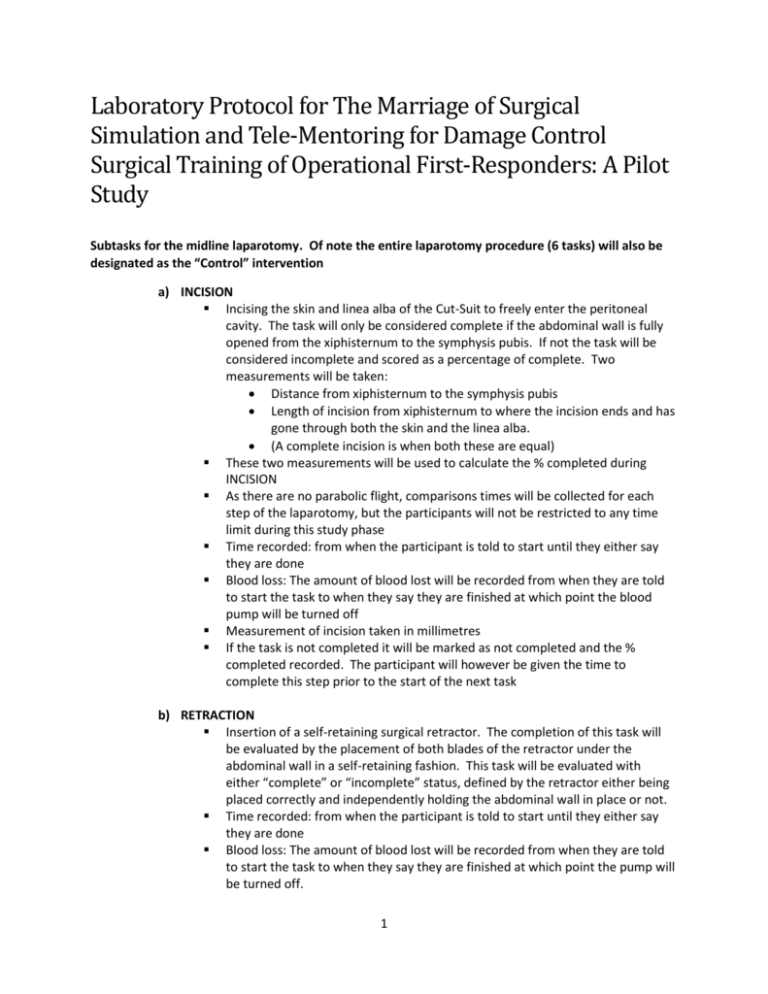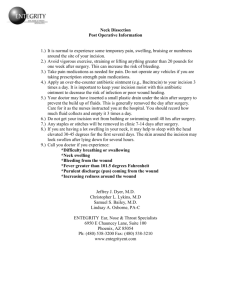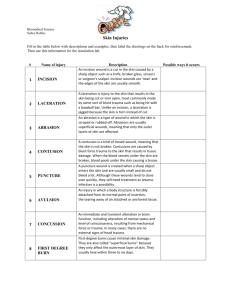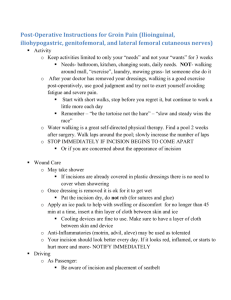Appendix A
advertisement

Laboratory Protocol for The Marriage of Surgical Simulation and Tele-Mentoring for Damage Control Surgical Training of Operational First-Responders: A Pilot Study Subtasks for the midline laparotomy. Of note the entire laparotomy procedure (6 tasks) will also be designated as the “Control” intervention a) INCISION Incising the skin and linea alba of the Cut-Suit to freely enter the peritoneal cavity. The task will only be considered complete if the abdominal wall is fully opened from the xiphisternum to the symphysis pubis. If not the task will be considered incomplete and scored as a percentage of complete. Two measurements will be taken: Distance from xiphisternum to the symphysis pubis Length of incision from xiphisternum to where the incision ends and has gone through both the skin and the linea alba. (A complete incision is when both these are equal) These two measurements will be used to calculate the % completed during INCISION As there are no parabolic flight, comparisons times will be collected for each step of the laparotomy, but the participants will not be restricted to any time limit during this study phase Time recorded: from when the participant is told to start until they either say they are done Blood loss: The amount of blood lost will be recorded from when they are told to start the task to when they say they are finished at which point the blood pump will be turned off Measurement of incision taken in millimetres If the task is not completed it will be marked as not completed and the % completed recorded. The participant will however be given the time to complete this step prior to the start of the next task b) RETRACTION Insertion of a self-retaining surgical retractor. The completion of this task will be evaluated by the placement of both blades of the retractor under the abdominal wall in a self-retaining fashion. This task will be evaluated with either “complete” or “incomplete” status, defined by the retractor either being placed correctly and independently holding the abdominal wall in place or not. Time recorded: from when the participant is told to start until they either say they are done Blood loss: The amount of blood lost will be recorded from when they are told to start the task to when they say they are finished at which point the pump will be turned off. 1 c) DIRECTION Direct and manage a surgical assistant to place and manipulate a hand-held abdominal retractors to augment visualization. This task will be evaluated with either “complete” or “incomplete” status, defined by the retractor either being placed correctly and independently holding the abdominal wall in place or not. Time recorded: from when the participant is told to start until they either say they are done Blood loss: The amount of blood lost will be recorded from when they are told to start the task to when they say they are finished at which point the blood pump will be turned off d) IDENTIFICATION Identification of the anatomic site of bleeding. The cut-suit will generate simulated bleeding from the liver. This task will be evaluated with either “complete” or “incomplete” status, defined by proper identification of the sites of bleeding or not. Time recorded: from when the participant is told to start until they either say they are done Blood loss: The amount of blood lost will be recorded from when they are told to start the task to when they say they are finished at which time the blood pump will be turned off e) HEMOSTASIS Control of the visceral bleeding through the manual application of hemostatic sponges. The participant will pack the wound they identified in the previous task. Blood loss from the cut-suit reservoir will then be measured for 120 seconds after the wound is packed. The success of this task will be evaluated by the volume of shed blood lost from the cut-suit reservoir during the 120 second period following the wound packing. Time recorded: from when the participant is told to start until they either say they are done Blood loss (1): The amount of blood lost will be recorded from when they are told to start the task to when they say they are finished Blood loss (2): The amount of blood lost will be recorded from when they say they are finished packing and thereafter for 120 seconds. The pump will then be turned off f) CLOSURE Suturing will be done using 2.0 PDS Sutures The suturing technique to be used is a continuous running “baseball” stitch that incorporates just the skin in order to fairly compare to the surgical clamp technique. Closure of the skin component will be evaluated in a similar manner as described for the fascial opening during INCISION. The closure will be rated as “closed” or “not closed” depending on whether the entire incisional length is closed and does not easily permit a finger to enter easily between the wound edges when probed. If the incision is not closed, the length of the incision from 2 where the finger easily enters the wound edge to the end of the incision will be measure in millimeters. In other words two measurements will be taken: the entire length of the wound will be measured the distance from where the wound is closed and that does not easily permit a finger to be easily inserted between the wound edges to the end of the open part of the wound If the wound is completely closed but still allows for a finger to be inserted into the wound edges then a % of closure will still be taken. % closure will be measured in the direction of suture closure. A measurement will be taken from where the finger can be inserted, to the end of the wound, in the direction being sutured. The measurement from finger inserted until end of the wound will be considered still open, even if it is closed. These two measurements will be used to calculate the % closure Time recorded: from when the participant is told to start until they either say they are done Blood loss: The amount of blood lost will be recorded from when they are told to start the task to when they say they are finished .The pump will then be turned off g) CLOSURE (PART ii – to be conducted after the original closure has been studied) The blood pump will be turned off Sutures that were placed will be removed The skin will be re-closed using multiple aplications of a number of iTClamps Closure of the skin component will be evaluated in a similar manner as described for the fascial opening during INCISION. The closure will be rated as “closed” or “not closed” depending on whether the entire incisional length is closed and does not easily permit a finger to enter between the wound edges when probed. If the incision is not closed, the length of the incision from where the finger enters the wound edge to the end of the incision will be measure in millimeters. In other words two measurements will be taken: the entire length of the wound will be measured the distance from where the wound is closed that does not permit a finger to be easily inserted between the wound edges to the end of the open part of the wound These two measurements will be used to calculate the % closure Time recorded: from when the participant is told to start until they either say they are done or they reach the time cap of 20 seconds Blood loss will not be recorded separately for this procedure. 3 Appendix A Primary Outcomes Comparison (the Question) 1) The comparison between the volume of overall blood shed comparing surgeons to mentored non-surgeons performing all phases of a damage control trauma laparotomy Planned Outcome Measures: PRIMARY OUTCOME MEASURE 1) The mean fluid shed during the CONTROL task (all six sub-tasks combined) for the following groups: a. Surgeons b. Non-surgeons c. Combined splenic and hepatic injury d. Combined splenic and hepatic injury/ surgeon performed e. Combined splenic and hepatic injury/ non surgeon performed SECONDARY OUTCOME MEASURES 2) Mean time to complete each of the subtasks (INCISION, RETRACTION, DIRECTION, IDENTIFICATION, CONTROL, AND CLOSURE). a. Mean time to complete INCISION b. Mean time to complete RETRACTION c. Mean time to complete DIRECTION d. Mean time to complete IDENTIFICATION e. Mean time to complete CONTROL f. Mean time to complete CLOSURE g. Mean time to complete INCISION/ surgeon performed h. Mean time to complete RETRACTION/ surgeon performed i. Mean time to complete DIRECTION/ surgeon performed j. Mean time to complete IDENTIFICATION/ surgeon performed k. Mean time to complete CONTROL/ surgeon performed l. Mean time to complete CLOSURE/ surgeon performed 4 m. Mean time to complete INCISION/ NON-surgeon performed n. Mean time to complete RETRACTION/ NON-surgeon performed o. Mean time to complete DIRECTION/ NON-surgeon performed p. Mean time to complete IDENTIFICATION/ NON-surgeon performed q. Mean time to complete CONTROL/ NON-surgeon performed r. Mean time to complete CLOSURE/ NON-surgeon performed 3) Mean time to the completion of the entire surgical task. Measured from beginning of INCISION to the end of CONTROL. (INCISION, RETRACTION, DIRECTION, IDENTIFICATION, CONTROL, AND CLOSURE). a. Mean time to completion of CONTROL/ surgeon performed b. Mean time to completion of CONTROL/ NON-surgeon performed c. Mean time to the completion of CONTROL 4) The mean fluid shed as measured lost from the Cut-suit reservoir during each of the six standard tasks (INCISION, RETRACTION, DIRECTION, IDENTIFICATION, CONTROL, AND CLOSURE) : a. Mean fluid loss for INCISION b. Mean fluid loss for RETRACTION c. Mean fluid loss for DIRECTION d. Mean fluid loss for IDENTIFICATION e. Mean fluid loss for CONTROL f. Mean fluid loss for CLOSURE g. Mean fluid loss for INCISION/ surgeon performed h. Mean fluid loss for RETRACTION/ surgeon performed i. Mean fluid loss for DIRECTION/ surgeon performed j. Mean fluid loss for IDENTIFICATION/ surgeon performed k. Mean fluid loss for CONTROL/ surgeon performed l. Mean fluid loss for CLOSURE/ surgeon performed m. Mean fluid loss for INCISION/ NON-surgeon performed n. Mean fluid loss for RETRACTION/ NON-surgeon performed o. Mean fluid loss for DIRECTION/ NON-surgeon performed p. Mean fluid loss for IDENTIFICATION/ NON-surgeon performed 5 q. Mean fluid loss for CONTROL/ NON-surgeon performed r. Mean fluid loss for CLOSURE/ NON-surgeon performed 5) The mean fluid shed for the standardized 1 minute after the CONTROL task for the following groups: a. Surgeons b. Non-surgeons c. Surgeons and non-surgeons combined 6) Proportion of each participants during the CLOSURE task with the sutures that are completed (no finger can be inserted), reporting mean times to closure with confidence intervals and descriptive stats a. Proportion completed for CLOSURE b. Proportion completed for CLOSURE/surgeon performed c. Proportion completed for CLOSURE/ NON-surgeon performed 7) Proportion of each participants during the CLOSURE task with the iTClamp that are completed (no finger can be inserted), reporting mean times to closure with confidence intervals and descriptive stats a. Proportion completed for CLOSURE b. Proportion completed for CLOSURE/surgeon performed c. Proportion completed for CLOSURE/ NON-surgeon performed 6 Appendix B Case Report Form Surgical Status: Pre Blood Amount: Start Time: Surgeon Non-surgeon Post Blood Amount: End Time: INCISION Distance from xiphisternum to the symphysis pubis: Length of Incision Task completion status % of task Completion Time to complete task (seconds) Blood loss Comments: Complete Incomplete RETRACTION Task completion status Time to complete task (seconds) Blood loss Comments: Complete Incomplete DIRECTION Task completion status Time to complete task (seconds) Blood loss Comments: Complete Incomplete IDENTIFICATION Task completion status Time to complete task (seconds) Blood loss Comments: Complete 7 Incomplete HEMOSTASIS Number of sponges used Time to complete task (seconds) Blood loss (1) Blood loss (2) Comments: CLOSURE Length of Incision Length of Incision closed Task completion status % of task Completion Time to complete task (seconds) Blood loss Comments: Complete Incomplete CLOSURE (PART II) Length of Incision Length of Incision closed Task completion status % of task Completion Time to complete task Number of clamps used Comments: Complete 8 Incomplete







